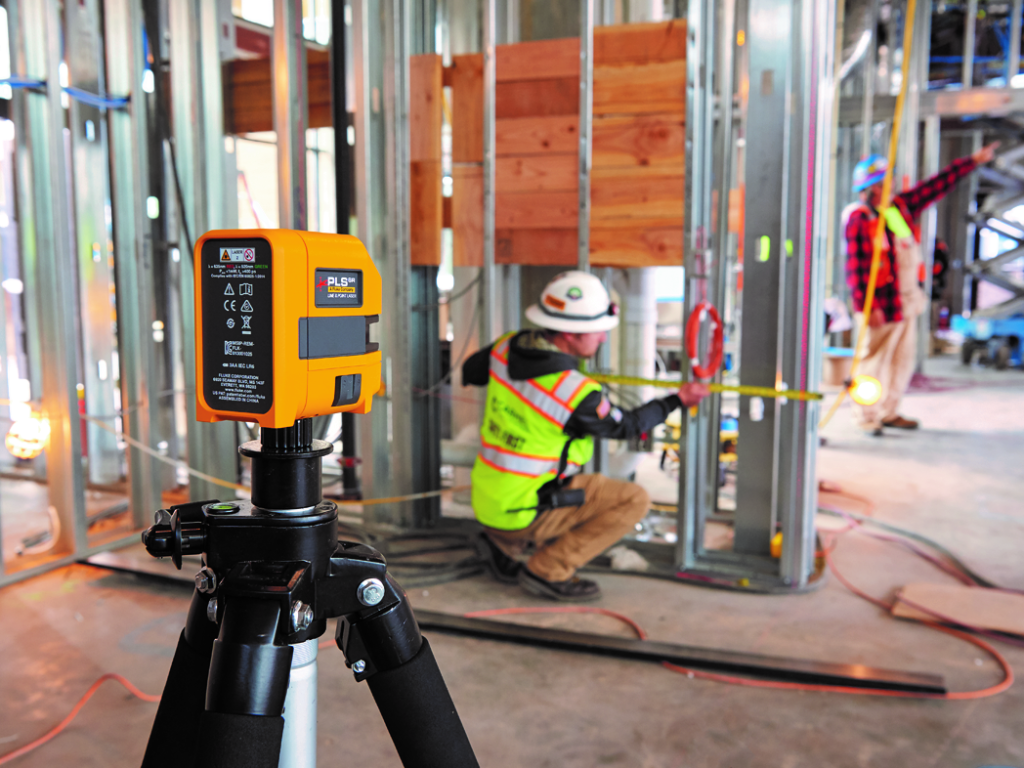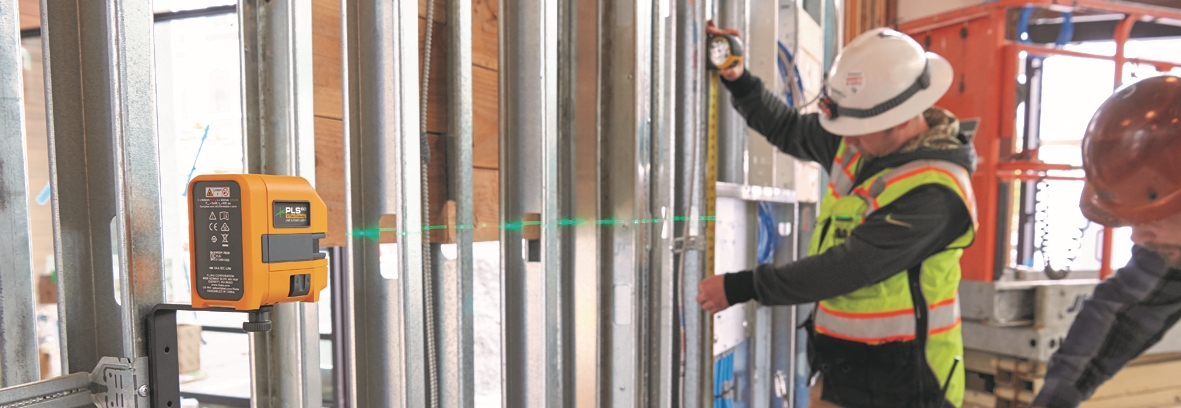Indispensable on construction sites and during renovations.
- Laser levels – what they are and what types are available
- Types of laser levels
- How a laser level works
- Advantages, possibilities, and selection
- Laser levels in TME’s offer
Although classical spirit levels with ether- or alcohol-filled vials are still in use, laser levels are commonly used in most applications. How they work, what possibilities they offer and what types and varieties can be found in TME’s offer – read more about it below.
Laser levels – what they are and what types are available
In simplest terms, laser level is an electronic device that projects a red or green beam along the horizontal and vertical axis. This description is, of course, very brief and requires some elaboration, starting with the fact that the height at which the beams are projected is adjustable within a range specified by the manufacturer – generally one that allows all interior work from floor level to the ceiling. It is also worth bearing in mind that these devices are small – weighing between half a kilo and one kilo – and fragile, so they need to be treated with great care and not allowed to fall or tilt suddenly. This precaution is advisable because of the sensitivity of the self-levelling mechanism, which can easily be damaged even on models equipped a safety switch.
Some laser levels are equipped with a tripod holder, laser rangefinder (very useful on any construction site), and LED displays that provide users with information such as the quality of the levelling, the height and angle of the beam projected onto the wall, and the amount of power remaining in the battery (rechargeable battery) or the estimated remaining working time until complete discharge. Many professional models are offered in sets with additional accessories such as dedicated clamps, clips, or holders for mounting them in unusual places (horizontal or vertical piping installations, hangers under the ceiling, etc.), as well as with compatible receivers, i.e., beam detectors used for determining the beam in sunlight. They can be very useful, because even strong green beams are virtually invisible in sunlight.
Types of laser levels
Laser levels can be categorised into groups based on various criteria. The most common levels project horizontal beams – the so-called classic spirit levels with beam angles up to 120°/140°/180°. There are also cross line laser levels, which are essentially spirit levels with additional vertical beams, enabling you to determine right angles. In addition to these, there are also 360° levels, the so-called three plane lasers that project laser beams at any angle. From the point of view of how these devices are mounted, there are spirit levels mounted on a tripod, which allows you to set them at a fixed height, and models without a tripod. Thinking about the way of levelling these devices, the manufacturers’ catalogues mention the self-levelling devices (thanks to the magnetic compensator) and those that must be levelled by the operator. All the mentioned levels can also be fitted with the aforementioned independent rangefinder; in the catalogues of some manufacturers, they may be classified as a different type of levels.
How a laser level works
Laser level projects a green or red beam. The laser is a highly focused and multi-amplified beam of light emitted by the LED diode. Its thickness (the smaller the better) depends on the parameters of the diode and the level of light concentration; ultra-thin beam enables maximum precision and minimises the potential error almost to zero, even over long distances of the order of 30-50 meters. The colour of the beam is also not without significance. The red, or standard, is optimal for indoor work, but may not be visible outdoors or in very bright rooms, so more and more models have a green beam that is four or even five times brighter than the red one. Of course, this does not come without a cost – the green beam consumes more energy and offers 1/2 or 2/3 less operating time than the red beam.
The heart of each laser level is the optoelectronic compensator, stabilized magnetically or pneumatically. Both types perform the same task: they self-level the device, moving within the limit of free movement specified by the manufacturer (usually +/- 3° to 5°). The point is to automatically align the laser beam with respect to the rotational axis for accurate horizontal and vertical alignment. This is only possible if the device is placed horizontally. If the allowable tilt margin is exceeded, many models will signal their inability to level by sound or light signals. When it comes to stabilizer types, it is necessary to explain their principle of operation. Namely, magnetic compensators (found much more often) have a kind of pendulum controlled by a system of magnets. In the case of a pneumatic stabiliser, the pendulum is positioned by a vibration damping system using air. The effectiveness of both is basically identical, except when a strong magnetic field acts on the magnetic compensator (nearby transformer or high voltage line). This can lead to system disruptions. More recently, some spirit levels have been fitted with so-called electronic compensators, which feature internal electronic level sensors sending information to a processor that controls the operation of the servo motor system. It is the most expensive, but at the same time the most accurate solution.
Advantages, possibilities, and selection
Laser levels make many jobs easier when it comes to renovation, assembly, taking precise measurements (rangefinder function) when laying any piping system or during the many jobs and processes that take place on a construction site. They also prove indispensable for very prosaic tasks, such as tiling a wall or fitting a shelf. Thanks to several maintenance-free modes, they allow one person to do the work that until recently would have required at least two professionals.

When choosing a laser level it is important to tailor the capabilities of specific models to our needs. To do so, several key parameters need to be analysed, such as the level’s range (measuring range), battery life, horizontal and vertical beam angle, measurement accuracy (i.e., the margin of error at a range of 10/20 metres), laser levelling range and accessories (e.g., soft carrying case for safe transportation). All these parameters must be in line with our expectations and the requirements of our tasks. It is worth to choose models from well-known manufacturers, offering rangefinder technology or the option of switching off individual beams to extend the working time of the battery. Dust- and watertightness of the device, which is related to dustiness and exposure to contaminants, e.g., during renovation works, is also of great importance. This parameter also translates into the ability to operate in high humidity conditions. Therefore, the IP54 rating is the minimum for professional indoor and outdoor use. Keep in mind that laser levels often work in unheated rooms in winter or in direct sunlight. Therefore, they should be able to withstand a wide range of operating and storage temperatures. The standard operating temperature is -10°C to +45°C, but models of the best manufacturers can operate even at temperatures from -20°C to +50°C.
The final factor to consider is the price. For typical renovation works, a level with two or three beams (cross line laser levels) and a rangefinder priced between EUR 80 and EUR 150 is enough. However, professionals are eager to reach for 360° laser levels designed to work at any angle, which give them maximum possibilities and often priced between EUR 100 to EUR 200 or more.
Laser levels in TME’s offer
The laser level offer in the TME catalogue is based on products from PLS, which is a FLUKE company. These are very high-end products, designed with professionals in mind and created by an engineering team with over 50 years of experience. TME offers 3PR and 180 LG models and various variants of PLS 6R, PLS 6G, PLS 180R, and PLS 180G levels, where the R stands for a red beam (Red), and the G stands for a green beam (Green). All of them work with an accuracy of 3 mm at a distance of 10 meters and project visible beams up to 15 meters as standard, point laser of up to 30 meters (PLS 6 series), and up to 60 meters with the use of laser line detectors. Each of these models also has a durable pendulum lock for safe transport.
The company has also prepared a set of accessories and additional parts. This includes cases, tripods, magnetic and ceiling/wall mounts, battery packs, toolboxes, detector clamps and much more.
Text prepared by Transfer Multisort Elektronik Sp. z o.o.
The original source of text: tme.eu












